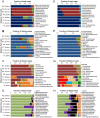Sulfur metabolizing microbes dominate microbial communities in Andesite-hosted shallow-sea hydrothermal systems
- PMID: 22970260
- PMCID: PMC3436782
- DOI: 10.1371/journal.pone.0044593
Sulfur metabolizing microbes dominate microbial communities in Andesite-hosted shallow-sea hydrothermal systems
Abstract
To determine microbial community composition, community spatial structure and possible key microbial processes in the shallow-sea hydrothermal vent systems off NE Taiwan's coast, we examined the bacterial and archaeal communities of four samples collected from the water column extending over a redoxocline gradient of a yellow and four from a white hydrothermal vent. Ribosomal tag pyrosequencing based on DNA and RNA showed statistically significant differences between the bacterial and archaeal communities of the different hydrothermal plumes. The bacterial and archaeal communities from the white hydrothermal plume were dominated by sulfur-reducing Nautilia and Thermococcus, whereas the yellow hydrothermal plume and the surface water were dominated by sulfide-oxidizing Thiomicrospira and Euryarchaeota Marine Group II, respectively. Canonical correspondence analyses indicate that methane (CH(4)) concentration was the only statistically significant variable that explains all community cluster patterns. However, the results of pyrosequencing showed an essential absence of methanogens and methanotrophs at the two vent fields, suggesting that CH(4) was less tied to microbial processes in this shallow-sea hydrothermal system. We speculated that mixing between hydrothermal fluids and the sea or meteoric water leads to distinctly different CH(4) concentrations and redox niches between the yellow and white vents, consequently influencing the distribution patterns of the free-living Bacteria and Archaea. We concluded that sulfur-reducing and sulfide-oxidizing chemolithoautotrophs accounted for most of the primary biomass synthesis and that microbial sulfur metabolism fueled microbial energy flow and element cycling in the shallow hydrothermal systems off the coast of NE Taiwan.
Conflict of interest statement
Figures






Similar articles
-
Phylogenetic relationships of Thiomicrospira species and their identification in deep-sea hydrothermal vent samples by denaturing gradient gel electrophoresis of 16S rDNA fragments.Arch Microbiol. 1995 Sep;164(3):165-72. doi: 10.1007/BF02529967. Arch Microbiol. 1995. PMID: 7545384
-
Culture-dependent and -independent characterization of microbial communities associated with a shallow submarine hydrothermal system occurring within a coral reef off Taketomi Island, Japan.Appl Environ Microbiol. 2007 Dec;73(23):7642-56. doi: 10.1128/AEM.01258-07. Epub 2007 Oct 5. Appl Environ Microbiol. 2007. PMID: 17921273 Free PMC article.
-
The metatranscriptome of a deep-sea hydrothermal plume is dominated by water column methanotrophs and lithotrophs.ISME J. 2012 Dec;6(12):2257-68. doi: 10.1038/ismej.2012.63. Epub 2012 Jun 14. ISME J. 2012. PMID: 22695860 Free PMC article.
-
Effects of shallow-water hydrothermal venting on biological communities of coastal marine ecosystems of the western Pacific.Adv Mar Biol. 2006;50:267-421. doi: 10.1016/S0065-2881(05)50004-X. Adv Mar Biol. 2006. PMID: 16782453 Review.
-
The microbiomes of deep-sea hydrothermal vents: distributed globally, shaped locally.Nat Rev Microbiol. 2019 May;17(5):271-283. doi: 10.1038/s41579-019-0160-2. Nat Rev Microbiol. 2019. PMID: 30867583 Review.
Cited by
-
Sulfur cycling connects microbiomes and biogeochemistry in deep-sea hydrothermal plumes.ISME J. 2023 Aug;17(8):1194-1207. doi: 10.1038/s41396-023-01421-0. Epub 2023 May 13. ISME J. 2023. PMID: 37179442 Free PMC article.
-
Endemicity of the cosmopolitan mesophilic chemolithoautotroph Sulfurimonas at deep-sea hydrothermal vents.ISME J. 2017 Apr;11(4):909-919. doi: 10.1038/ismej.2016.178. Epub 2017 Jan 3. ISME J. 2017. PMID: 28045457 Free PMC article.
-
Genome sequence of Sulfurimonas sp. C5, a potential chemolithoautotrophic, sulfur-oxidizing bacterium isolated from a mangrove sediment.Microbiol Resour Announc. 2024 Nov 12;13(11):e0047424. doi: 10.1128/mra.00474-24. Epub 2024 Sep 24. Microbiol Resour Announc. 2024. PMID: 39315832 Free PMC article.
-
Diversity and Distribution of Archaea in the Mangrove Sediment of Sundarbans.Archaea. 2015 Aug 6;2015:968582. doi: 10.1155/2015/968582. eCollection 2015. Archaea. 2015. PMID: 26346219 Free PMC article.
-
Diversity of Total Bacterial Communities and Chemoautotrophic Populations in Sulfur-Rich Sediments of Shallow-Water Hydrothermal Vents off Kueishan Island, Taiwan.Microb Ecol. 2017 Apr;73(3):571-582. doi: 10.1007/s00248-016-0898-2. Epub 2016 Dec 1. Microb Ecol. 2017. PMID: 27909749
References
-
- Tarasov VG, Gebruk AV, Mironov AN, Moskalev LI (2005) Deep-sea and shallow-water hydrothermal vent communities: two different phenomena? Chem Geol 224: 5–39.
-
- Maugeri TL, Bianconi G, Canganella F, Danovaro R, Gugliandolo C, et al. (2010) Shallow hydrothermal vents in the southern Tyrrhenian Sea. Chem Ecol 26: 285–298.
-
- Chen C-TA, Zeng Z, Kuo F-W, Yang TF, Wang B-J, et al. (2005) Tide-influenced acidic hydrothermal system offshore NE Taiwan. Chem Geol 224: 69–81.
-
- Liu C-H, Wang X-M, Zeng Z-G, Yin X-B, Chen C-TA, et al. (2010) Origin of the hydrothermal fluid of the shallow sea near Kueishantao Island. Marine Sciences (Chinese) 34: 61–68.
-
- Zeng Z-G, Liu C-H, Chen C-tA, Yin X-b, Chen D-G, et al. (2007) Cause of formation of sulfur chimneys in the hydrothermal fields near Kueishantao islet of NE Taiwan. Sci China Ser D (Chinese) 37: 1134–1140.
Publication types
MeSH terms
Substances
LinkOut - more resources
Full Text Sources

